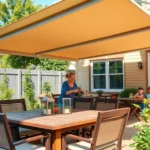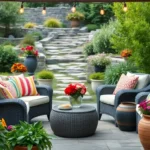We spend countless hours in our kitchens preparing meals sharing stories and creating memories. Yet many of us settle for outdated designs that don’t reflect our personal style or maximize functionality. Your kitchen deserves better than generic cabinets and cramped layouts that make cooking feel like a chore.
The good news? Transforming your kitchen doesn’t require a complete overhaul or very costly. With the right interior design strategies you can create a space that’s both beautiful and practical. Whether you’re working with a compact galley kitchen or a spacious open-concept layout there are proven techniques to maximize every square inch.
We’ve gathered the most effective kitchen interior ideas that blend style with functionality. From smart storage answers and color schemes to lighting tricks and layout optimizations these strategies will help you design a kitchen that truly works for your lifestyle. Let’s explore how to turn your kitchen into the heart of your home.
Modern Minimalist Kitchen Interior Ideas
We’ve found that modern minimalist kitchens create serene spaces that prioritize function over clutter. These designs transform busy cooking areas into calm, efficient environments.
Clean Lines and Sleek Surfaces
Flat-panel cabinets eliminate visual noise by removing raised details and ornate hardware. We recommend choosing handleless cabinet doors or selecting slim, linear pulls that blend seamlessly with the cabinet surface. Quartz countertops provide smooth, uninterrupted surfaces that resist stains and require minimal maintenance.
Integrated appliances create seamless kitchen flows by concealing refrigerators, dishwashers, and microwaves behind matching cabinet panels. Built-in cooktops sit flush with countertops to maintain clean sightlines. We suggest selecting appliances with touch controls rather than protruding knobs to preserve the streamlined aesthetic.
Geometric backsplashes using large-format tiles reduce grout lines and create unbroken visual planes. Subway tiles arranged in straight patterns work better than complex herringbone designs for minimalist spaces. Glass or ceramic surfaces reflect light and make small kitchens appear larger.
Neutral Color Palettes
White and gray combinations form the foundation of minimalist kitchen color schemes. We prefer warm whites like ivory or cream over stark white to create inviting atmospheres. Light gray cabinets paired with white countertops offer subtle contrast without overwhelming the space.
Monochromatic schemes using varying shades of the same color create sophisticated depth. Charcoal lower cabinets combined with lighter gray uppers add visual interest while maintaining color harmony. Black accents through faucets, light fixtures, or cabinet hardware provide dramatic focal points.
Natural wood tones introduce warmth to otherwise cool color palettes. Light oak or maple cabinet faces balance stark white walls and countertops. We recommend limiting wood elements to one or two surfaces to avoid disrupting the minimalist aesthetic.
Hidden Storage Answers
Floor-to-ceiling cabinets maximize storage capacity while maintaining clean wall surfaces. Upper cabinets extending to the ceiling eliminate dust-collecting gaps and create impressive vertical lines. We suggest using interior organizers like pull-out drawers and lazy Susans to make high shelves accessible.
Integrated pantry systems conceal food storage behind seamless cabinet doors. Pull-out pantry units fit into narrow spaces between appliances or at the end of cabinet runs. Built-in spice racks and can organizers keep frequently used items organized yet invisible.
Multi-functional islands provide storage, seating, and workspace in single furniture pieces. We recommend islands with built-in wine storage, trash bins, or small appliance garages. Waterfall countertops that extend to the floor hide storage compartments while creating striking visual elements.
Rustic Farmhouse Kitchen Interior Ideas
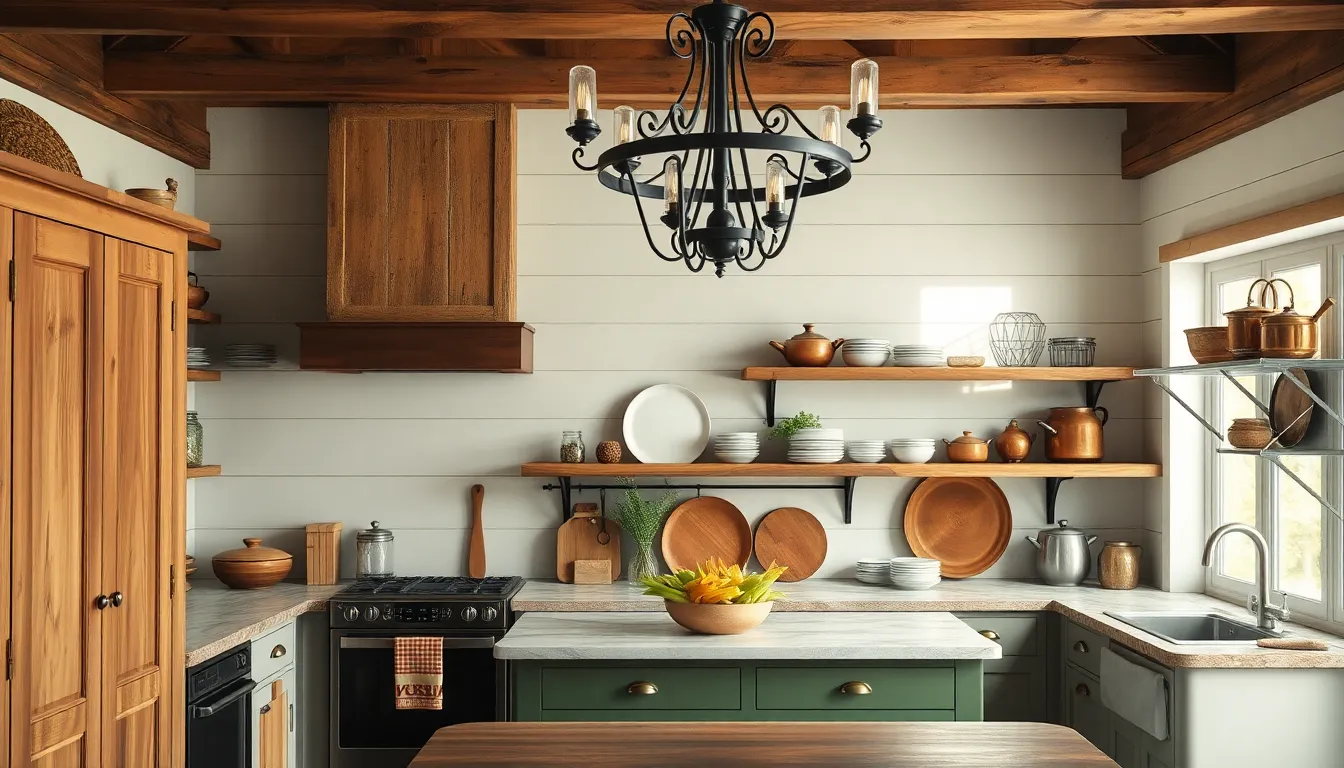
While modern minimalist designs create sleek sophistication, rustic farmhouse kitchens offer the opposite charm through weathered textures and vintage character. We’re embracing warmth and nostalgia by incorporating authentic elements that transform sterile cooking spaces into cozy gathering spots.
Exposed Wood Beams and Shiplap Walls
Exposed wood beams create dramatic focal points that draw the eye upward while adding architectural interest to flat ceilings. We recommend installing reclaimed barn wood or distressed pine beams to achieve authentic farmhouse character. Staining the beams in rich walnut tones enhances their natural grain patterns, while leaving them unstained preserves their raw, weathered appearance.
Shiplap walls serve as the quintessential farmhouse backdrop that complements exposed beams perfectly. Installing horizontal shiplap planks creates visual width in narrow kitchens, making spaces feel more expansive. Painting shiplap in crisp white brightens darker areas, while natural wood finishes add warmth and texture. We suggest extending shiplap from floor to ceiling on accent walls for maximum impact.
Vintage Hardware and Fixtures
Cabinet hardware in aged brass or oil rubbed bronze finishes instantly transforms modern cabinetry into farmhouse treasures. We choose bin pulls, cup handles, and latches that show deliberate wear patterns and patina development. Oversized knobs and handles create bold statements while maintaining functionality for daily use.
Lighting fixtures anchor the vintage aesthetic through carefully selected pendant lights and chandeliers. Mason jar pendant lights illuminate kitchen islands with soft, diffused lighting that enhances the cozy atmosphere. We incorporate wrought iron chandeliers with candle style bulbs to create dramatic dining areas within the kitchen space.
Plumbing fixtures complete the vintage look through bridge style faucets and farmhouse sinks. Copper and brass faucets develop natural patina over time, adding authentic character that can’t be replicated. We select fixtures with cross handles and gooseneck spouts that reference traditional farm utility.
Open Shelving with Mason Jars
Open shelving systems replace upper cabinets to create airy, accessible storage that showcases vintage collections. We install floating shelves using reclaimed wood planks supported by wrought iron brackets for authentic farmhouse appeal. Thick wooden shelves display antique dishes, copper pots, and ceramic crocks that serve as functional decoration.
Mason jar storage transforms everyday kitchen essentials into charming displays while maintaining organization. We fill clear mason jars with pasta, grains, and spices to create uniform storage answers that look intentionally curated. Vintage blue and green mason jars add color pops when filled with fresh flowers or dried herbs from the garden.
Display arrangements combine practical items with decorative elements to achieve balanced, lived in aesthetics. Wooden cutting boards lean against walls between ceramic pitchers and copper measuring cups. We group items in odd numbers and vary heights to create visual interest without appearing cluttered or staged.
Contemporary Industrial Kitchen Interior Ideas

We’re shifting gears from cozy farmhouse charm to embrace the raw, utilitarian beauty of contemporary industrial kitchen design. These spaces blend modern functionality with warehouse-inspired aesthetics to create kitchens that are both stylish and supremely practical.
Exposed Brick and Metal Elements
Exposed brick walls serve as the cornerstone of industrial kitchen design, adding texture and warmth while maintaining that coveted unfinished look. We recommend leaving original brick exposed or installing thin brick veneers to achieve this authentic industrial foundation. The rough, weathered surfaces create visual interest without overwhelming the space.
Metal elements reinforce the industrial vibe through strategic placement throughout the kitchen. Steel shelving units, metal bar stools, and iron cabinet hardware provide durability while staying true to the aesthetic. We particularly love incorporating stainless steel appliances, copper pipe accents, and wrought iron pot racks to layer different metal finishes. These elements work together to create depth and character while maintaining the raw, utilitarian feel that defines industrial design.
Concrete Countertops
Concrete Countertops have become increasingly popular for their sleek, minimalist appearance and exceptional toughness. We appreciate how their raw, matte finish enhances the industrial aesthetic while providing a practical work surface that can withstand daily kitchen demands. The beauty of concrete lies in its customization potential – you can adjust color, texture, and even embed decorative elements to match your personal style.
Balanced contrasts emerge when concrete pairs with both metal and wood elements in the kitchen. We’ve seen stunning results when concrete counters complement exposed brick walls and steel fixtures, creating a cohesive industrial look. The neutral gray tones of concrete also serve as an excellent backdrop for colorful accessories or natural wood cutting boards, preventing the space from feeling too cold or sterile.
Edison Bulb Lighting Features
Edison bulb fixtures play a vital role in industrial kitchen design by providing warm, vintage-style illumination that recalls old factories and warehouses. We recommend suspending these bulbs by fabric-wrapped cords or mounting them on exposed metal pipes to create authentic industrial lighting installations. The warm glow from Edison bulbs softens the harder edges of metal and concrete surfaces.
Functional and decorative focal points define the best Edison bulb applications in industrial kitchens. We suggest using pendant arrangements over kitchen islands or dining areas, where they complement exposed beams or brick backdrops beautifully. Track lighting with Edison bulbs also works well for task lighting over work areas, combining the vintage aesthetic with modern functionality. The key is balancing the number of fixtures to provide adequate illumination without overwhelming the space’s clean, utilitarian design principles.
Traditional Classic Kitchen Interior Ideas
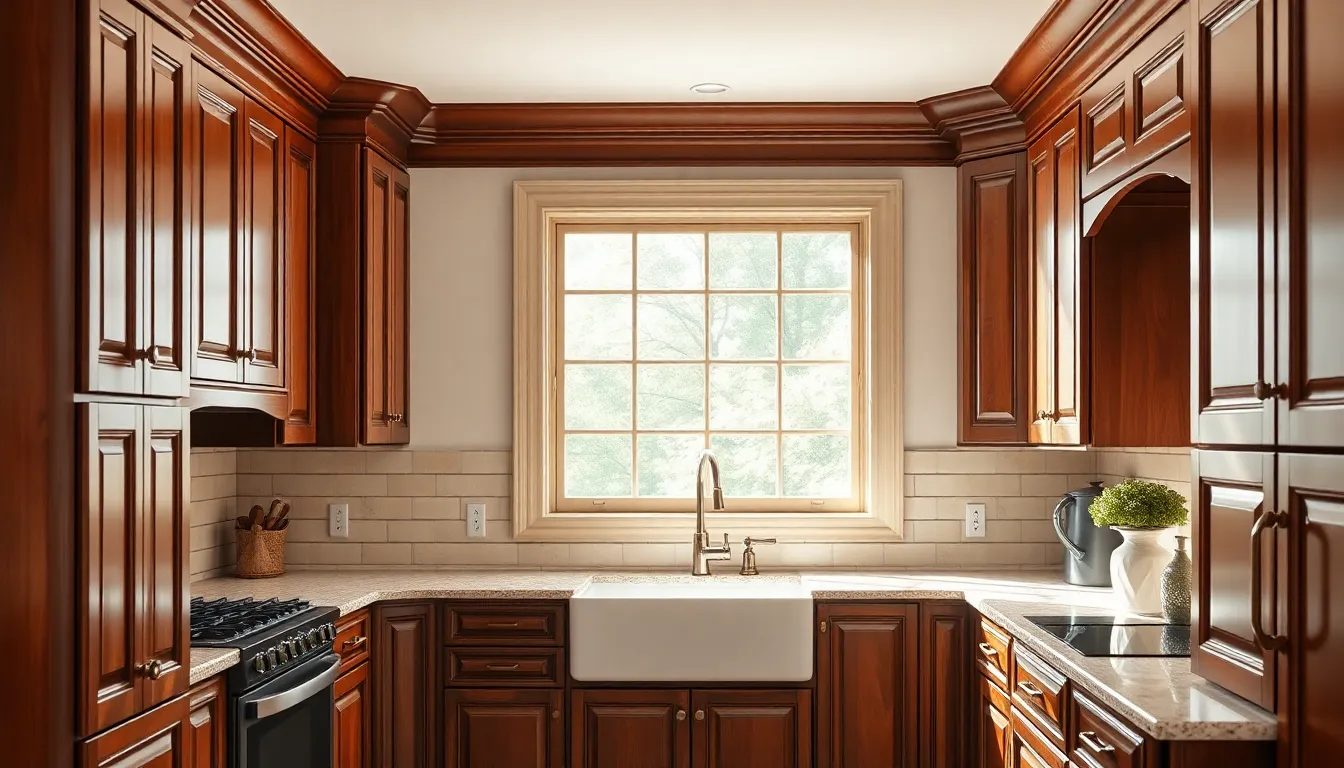
Traditional classic kitchens offer timeless elegance that never goes out of style, creating spaces where comfort meets sophisticated design.
Rich Wood Cabinetry
Rich wood cabinetry forms the foundation of traditional classic kitchen design, delivering both warmth and enduring appeal. Cherry, oak, and walnut species stand out as the most popular choices, each bringing distinct character to your kitchen space. Medium to dark stains enhance the natural grain patterns, creating depth and visual interest that synthetic materials simply can’t match.
Painted finishes in classic whites and creams provide versatility for homeowners who prefer lighter tones. These neutral options pair beautifully with various countertop materials and backsplash designs. Durability becomes a key advantage with properly finished wood cabinetry, often lasting decades with minimal maintenance when quality construction methods are used.
Ornate Crown Molding Details
Ornate crown molding details elevate traditional kitchens by adding architectural sophistication and visual height. Crown moldings create seamless transitions between cabinetry and ceilings, establishing a cohesive look throughout the space. Decorative corbels and paneled doors complement these trim elements, reinforcing the sense of craftsmanship that defines classic design.
Layered molding profiles add dimensional interest without overwhelming the overall aesthetic. These architectural features help define the kitchen’s perimeter, creating natural focal points that draw the eye upward. Professional installation ensures proper proportions, with molding height typically matching one-third of the cabinet face height for balanced visual appeal.
Timeless Subway Tile Backsplashes
Timeless subway tile backsplashes serve as the perfect backdrop for traditional classic kitchens, offering clean lines that complement rich wood elements. White and neutral subway tiles provide the most versatile foundation, working seamlessly with both painted and stained cabinetry options. Simple grid patterns create subtle texture without competing with other design elements in the space.
Colored or textured subway tile variations add visual interest while maintaining traditional appeal. Beveled edges catch light beautifully, creating subtle shadows that enhance the tile’s dimensional quality. Installation patterns like herringbone or vertical stacking can modernize the classic subway look while preserving its timeless character.
Scandinavian-Inspired Kitchen Interior Ideas

Scandinavian design brings serenity and sophistication to kitchen spaces through clean lines, natural materials, and thoughtful functionality. We’ll explore how this Nordic approach creates calming, inviting atmospheres that prioritize both beauty and practical daily use.
Light Wood Finishes
Light wood finishes form the foundation of authentic Scandinavian kitchen design, bringing warmth and natural texture to create bright, airy environments. Oak stands as the most popular choice, offering durability and beautiful grain patterns that enhance the overall aesthetic. Ash provides another excellent option with its pale tones and smooth texture, perfect for creating seamless cabinet faces and countertop surfaces.
Beech wood delivers exceptional versatility, allowing us to incorporate both light and slightly darker tones while maintaining the characteristic Scandinavian look. These light toned woods maximize natural light reflection throughout the space, creating an open feel that’s central to Nordic design principles. We recommend using these finishes on cabinet doors, floating shelves, and kitchen islands to establish visual continuity.
The natural texture of light wood brings organic warmth that balances the clean, minimalist lines typical of Scandinavian interiors. Installing wood finishes on both upper and lower cabinetry creates cohesive flow while avoiding the stark appearance that purely white kitchens can sometimes produce.
White and Light Color Schemes
White dominates Scandinavian kitchen color palettes, serving as the primary foundation that maximizes natural light and enhances spatial perception. Pale gray complements white beautifully, adding subtle depth without overwhelming the clean aesthetic that defines Nordic design. Soft cream tones introduce gentle warmth while maintaining the bright, open atmosphere essential to Scandinavian style.
Muted pastels work exceptionally well as accent colors, particularly in textiles, small appliances, or decorative elements throughout the kitchen space. This light color approach reflects and amplifies available natural light, making even smaller kitchens feel spacious and inviting. We’ve found that combining various shades of white creates visual interest without sacrificing the serene quality that makes Scandinavian kitchens so appealing.
The strategic use of light colors extends beyond walls and cabinetry to include backsplashes, window treatments, and even flooring materials. This comprehensive approach ensures every surface contributes to the overall brightness and sense of space that characterizes authentic Scandinavian design.
Functional Yet Beautiful Storage
Functional storage answers in Scandinavian kitchens blend utility with visual appeal, creating organized spaces that maintain the style’s signature clean appearance. Minimalist cabinetry features hidden storage compartments that keep countertops clutter free while providing easy access to kitchen essentials. Open shelving systems showcase beautiful dishware and cooking tools, turning everyday items into decorative elements.
Thoughtful organization plays a crucial role in maintaining the sleek, uncluttered look that defines Scandinavian kitchen design. Drawers with internal dividers and pull out systems allow us to maximize storage efficiency while keeping everything easily accessible during daily cooking activities. We recommend installing floor to ceiling cabinets that use vertical space without creating visual weight.
Custom storage answers like built in spice racks, utensil organizers, and pantry systems help maintain the minimalist aesthetic while ensuring every item has its designated place. The key lies in choosing storage options that serve dual purposes, combining practical functionality with the clean lines and natural materials that make Scandinavian kitchens both beautiful and highly functional.
Mediterranean Kitchen Interior Ideas
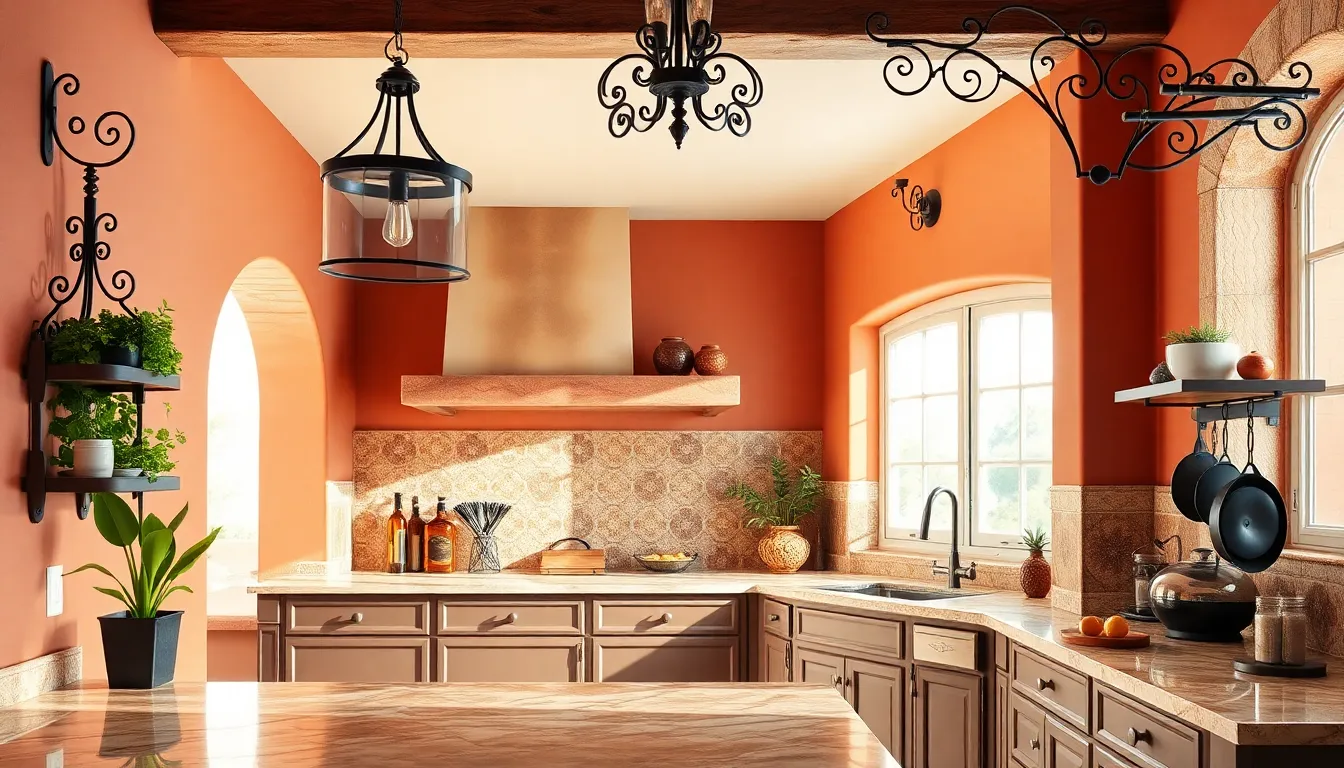
Mediterranean kitchen designs transport us to the sun-drenched coastal regions of Southern Europe, blending timeless elegance with warm, inviting elements that create spaces perfect for gathering and cooking.
Warm Terracotta and Earth Tones
Terracotta colors form the heart of Mediterranean kitchen design, bringing the warmth of Italian hillsides and Greek islands into our homes. We can incorporate these rich, earthy hues through wall paint, cabinet finishes, or decorative tiles that instantly evoke the Mediterranean industry. Olive and sage greens complement terracotta beautifully, creating a palette that feels both sophisticated and naturally grounded.
Sea-inspired blues add coastal charm when paired with these warm tones, while sun-kissed yellows brighten the space with Mediterranean sunshine. These colors work together to create a vibrant yet soothing atmosphere that makes our kitchens feel like welcoming retreats. We can introduce these hues through textiles, pottery, and accessories to build layers of authentic Mediterranean character.
Natural Stone Countertops
Granite and marble countertops bring natural elegance that perfectly captures the Mediterranean aesthetic. These stone surfaces provide the durability we need for busy kitchens while adding sophisticated texture that complements warm earth tones. Natural stone creates a beautiful contrast against terracotta cabinetry and adds timeless appeal that won’t go out of style.
We can choose from various stone finishes to achieve different looks, from polished marble that reflects light beautifully to honed granite that offers subtle sophistication. These natural materials connect our kitchens to the ancient stone architecture found throughout Mediterranean coastal towns. The organic patterns and colors in natural stone create visual interest that synthetic materials simply can’t replicate.
Wrought Iron Decorative Elements
Wrought iron elements add vintage charm and rustic character that defines authentic Mediterranean style. We can incorporate these decorative pieces through lighting fixtures like pendant lights or chandeliers that cast beautiful shadows and create focal points. Pot racks made from wrought iron provide both functional storage and visual appeal, showcasing our cookware while maintaining the Mediterranean theme.
Decorative frames, cabinet hardware, and window treatments featuring wrought iron details enhance the vintage atmosphere we’re creating. These metal accents pair beautifully with warm terracotta walls and natural stone surfaces, creating the perfect balance of rustic and refined elements. We can also use wrought iron for bar stools, shelving brackets, or decorative wall art to reinforce the Mediterranean aesthetic throughout our kitchen space.
Small Space Kitchen Interior Ideas
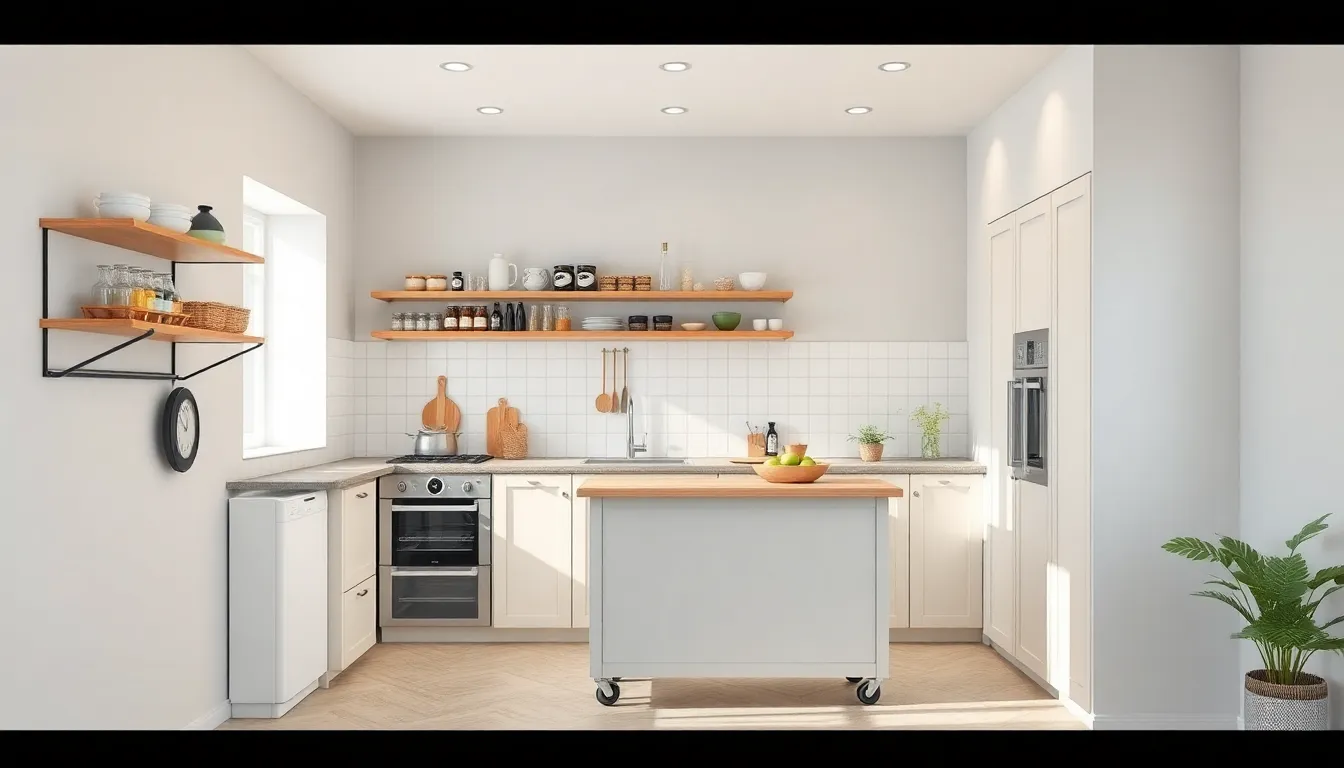
Creating a functional and beautiful kitchen in limited square footage requires strategic design choices that maximize every inch. We’ll explore proven techniques that transform cramped cooking spaces into efficient culinary havens.
Vertical Storage Answers
Utilizing tall cabinets transforms wasted wall space into valuable storage areas for cookware and pantry items. Install floor-to-ceiling cabinetry to store dishes, pots, and seasonal appliances while keeping countertops clear for food preparation.
Mounting open shelving systems creates accessible storage for frequently used items like spices, oils, and cooking utensils. Position floating shelves near cooking zones to reduce movement between storage and workspace areas.
Installing hanging racks on unused wall sections provides convenient storage for pots, pans, and kitchen tools. These vertical answers free up valuable drawer and cabinet space for other essential items.
Adding magnetic strips to walls keeps knives and metal utensils organized and easily accessible. This approach eliminates the need for bulky knife blocks on already limited counter space.
Multi-Functional Furniture Pieces
Incorporating rolling kitchen islands provides additional workspace that moves where you need it most. These mobile units often include built-in storage compartments for cookbooks, linens, and small appliances.
Installing fold-down tables creates temporary dining or prep surfaces that disappear when not needed. Wall-mounted drop-leaf tables work particularly well in galley kitchens where floor space is at a premium.
Choosing banquette seating with built-in storage maximizes both seating capacity and organizational space. These custom answers can house table linens, serving pieces, and seasonal kitchen items.
Selecting bar stools that tuck completely under counters eliminates visual clutter in tight spaces. Stackable options provide flexibility for entertaining while maintaining clean sight lines.
Light Colors to Maximize Space
Painting walls in warm whites and light grays creates an illusion of expanded square footage. Light neutral tones reflect available light throughout the space, making small kitchens feel more open and airy.
Choosing light-colored cabinetry enhances the perception of spaciousness while maintaining design cohesion. Soft cream, pale gray, and off-white cabinet finishes work with various design styles from modern to traditional.
Installing reflective surfaces like glossy subway tiles or mirrored backsplashes amplifies natural and artificial light. These surfaces bounce light around the room, creating depth and visual interest.
Selecting light countertops in materials like white quartz or pale marble continues the bright color scheme. Light surfaces make small kitchens feel less cramped while providing practical workspace for meal preparation.
Open Concept Kitchen Interior Ideas
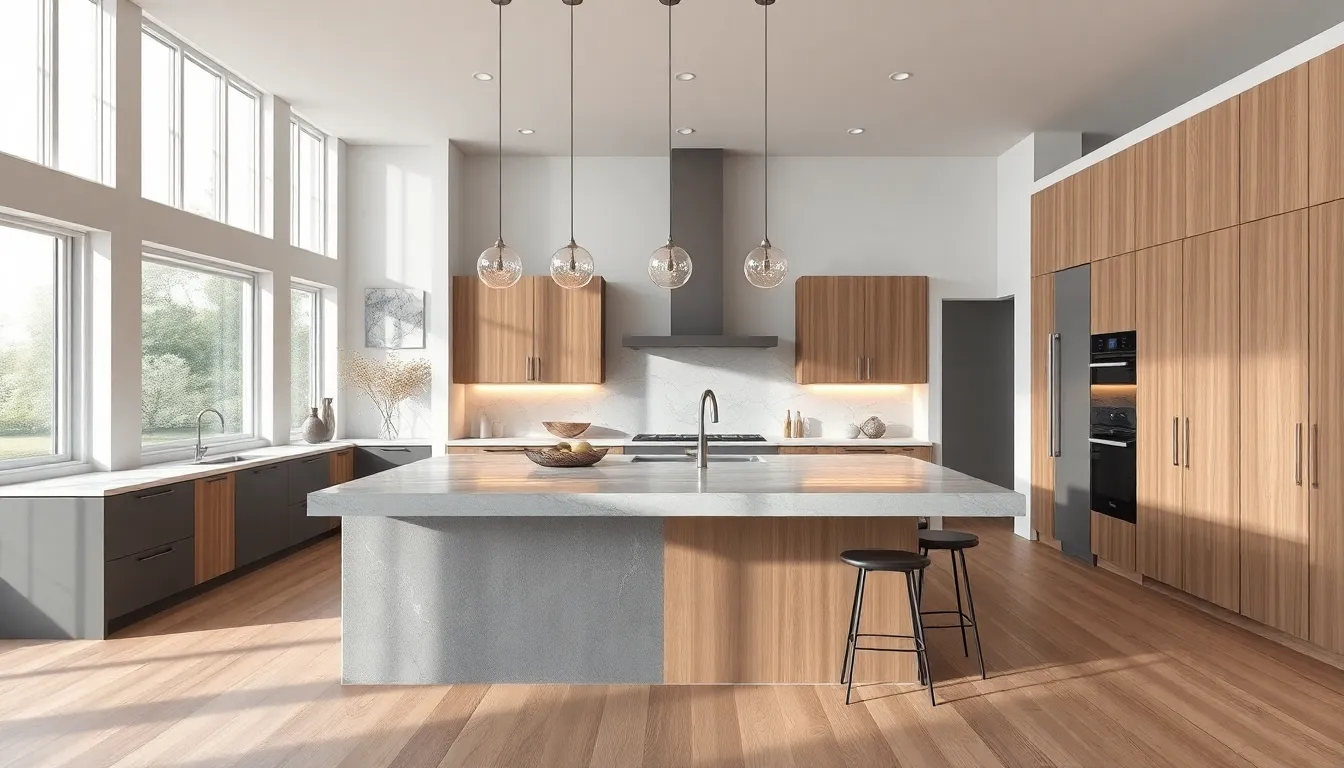
Open concept kitchens blur the boundaries between cooking, dining, and living spaces to create unified environments that foster connectivity and maximize natural light. We’ll explore how strategic design choices can transform your kitchen into a seamless hub that supports both daily life and entertaining.
Kitchen Island as Room Divider
Islands serve as multi-functional centerpieces that offer additional prep space, storage, and seating while subtly separating kitchen areas from adjoining rooms. We recommend designing your island to maintain visual connection and traffic flow without disrupting the airy feel of your open concept space.
Position your island to create natural zones for cooking, dining, and socializing. Include features like built-in seating, wine storage, or a second sink to enhance functionality. Consider waterfall countertops or contrasting materials to make your island a striking focal point that anchors the entire space.
Cohesive Color Flow Throughout
Neutral tones and natural materials create harmonious transitions between open concept zones while minimizing visual clutter. We suggest using soft whites, warm grays, and natural wood finishes as your foundation to establish calm, continuous spaces throughout your kitchen and adjacent areas.
Accent colors should be used sparingly to define key areas without overwhelming the unified palette. Choose one or two accent shades that complement your surrounding rooms, applying them to elements like your island, bar stools, or artwork. Stone countertops and wood cabinetry provide natural texture that enhances the cohesive flow.
Strategic Lighting Zones
Layered lighting combines recessed fixtures, pendant lights, and under-cabinet illumination to create distinct zones within your shared space. We recommend installing pendants over your island for task lighting, recessed lights for general illumination, and softer fixtures in dining areas to establish ambiance.
Under-cabinet lighting eliminates shadows on work surfaces while track lighting offers flexibility for highlighting exact areas. Consider dimmer switches for each lighting zone to adjust brightness throughout the day. Warm LED bulbs create an inviting atmosphere that connects your kitchen seamlessly with surrounding living spaces.
Bold and Colorful Kitchen Interior Ideas
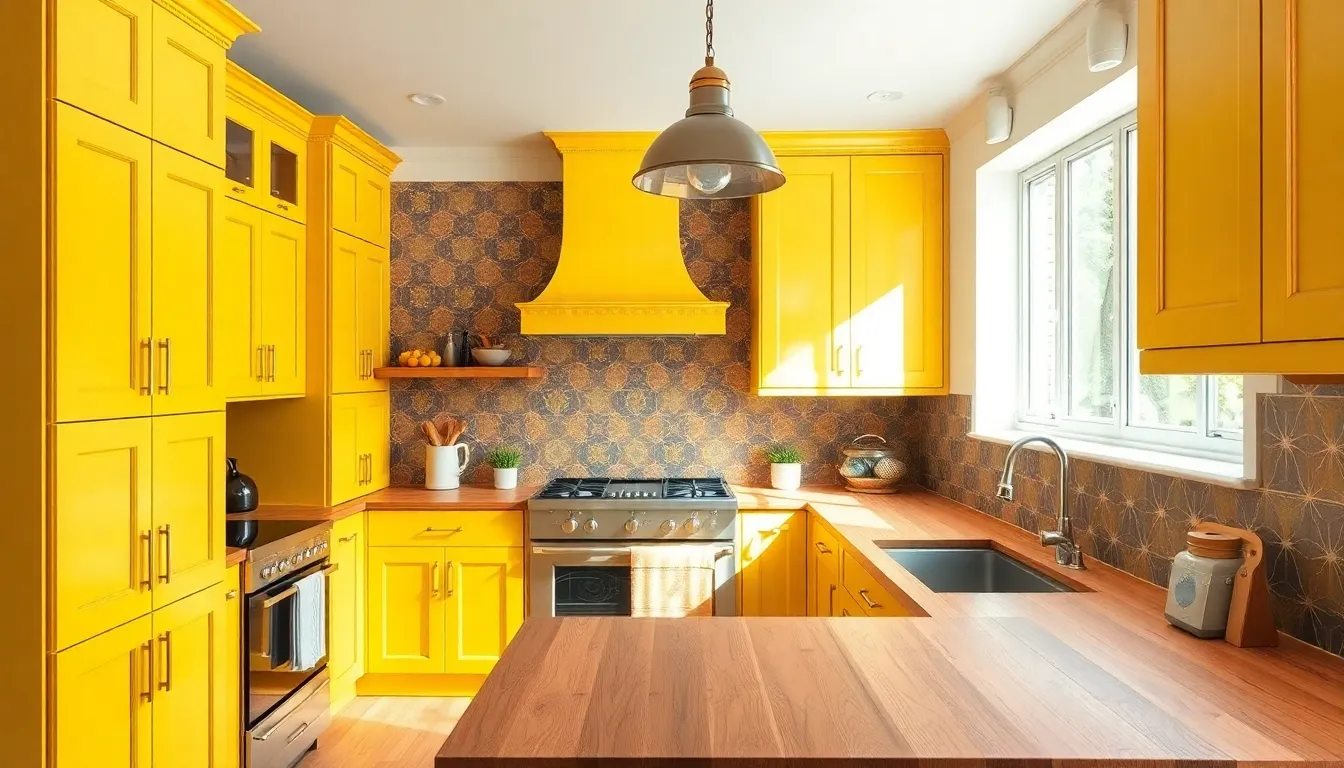
We’re diving into vibrant kitchen design territory where personality takes center stage. Colors become powerful tools that transform ordinary cooking spaces into extraordinary expressions of personal style.
Statement Cabinet Colors
Cheerful yellow cabinets create bright and inviting atmospheres that energize our daily cooking routines. These sunny hues pair beautifully with butcher block countertops and white accents for sophisticated yet welcoming looks.
Elegant green offers rich natural vibes through dark or olive tones that ground the space with earthy sophistication. Sage green delivers soft and calming feels that work perfectly with copper or brass hardware accents.
Bold red makes warm energetic statements through crimson or burgundy finishes that demand attention. We recommend balancing these passionate hues with neutral walls to prevent overwhelming the space.
Playful pink adds unexpected charm when combined with marble countertops and gold details for modern touches. These blush tones create sophisticated femininity that defies traditional kitchen color rules.
Sophisticated navy blue creates timeless contemporary looks when paired with white walls and marble surfaces. Deep blacks offer moody cohesive aesthetics for those seeking dramatic sophistication.
Neon yellows provide electric pops of color that defy conventional norms while sparking joy in unexpected ways. These brave choices reward homeowners who embrace bold design decisions.
Vibrant Backsplash Designs
Patterned tiles bring energy and personality into kitchens through geometric designs and artistic expressions. We see these colorful elements improving both bold cabinet choices and neutral foundations with equal success.
Bright color palettes extend from floor tiles to backsplash areas creating cohesive visual interest throughout the space. These design decisions inject personality while complementing existing colorful cabinets or balancing neutral elements.
Creative textures combine with vibrant hues to add sophisticated flair depending on chosen color combinations. We recommend selecting backsplash designs that either harmonize with cabinet colors or provide striking contrasts.
Eye-Catching Hardware Choices
Metallic finishes elevate colorful kitchens through carefully selected knobs pulls and handles that complete the design vision. Copper bronze brass and gold provide warmth and polish to bold cabinet colors especially green or pink installations.
Contrasting hardware creates visual balance by offsetting vibrant cabinet hues with complementary metal tones. We suggest choosing finishes that either harmonize with existing colors or provide intentional contrast for ever-changing appeal.
Hardware weight becomes crucial in colorful kitchens where visual elements compete for attention throughout the space. Balancing these decorative elements ensures cohesive designs that feel intentional rather than chaotic.
Budget-Friendly Kitchen Interior Ideas
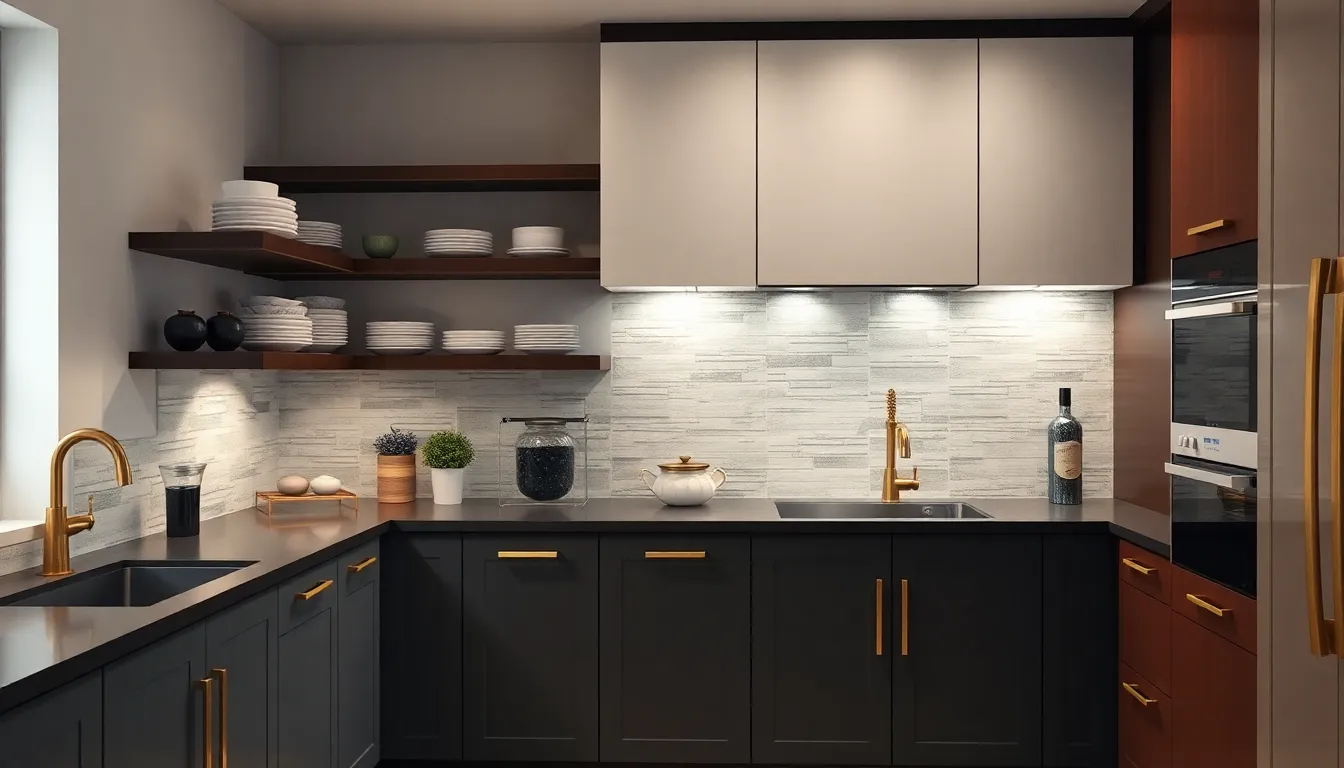
Transforming your kitchen doesn’t require a massive renovation budget when you focus on strategic updates that deliver maximum impact. We can achieve stunning results through smart DIY projects and affordable alternatives that refresh the space without very costly.
DIY Cabinet Makeovers
Painting existing cabinets transforms the entire kitchen aesthetic for a fraction of replacement costs. We recommend using contrasting colors for upper and lower cabinets to add visual depth and create a custom designer look that reflects your personal style.
Replacing cabinet hardware offers another quick win that modernizes outdated cabinetry instantly. Swapping old knobs and pulls for contemporary brushed gold, matte black, or sleek stainless steel options creates an immediate upgrade that costs under $200 for most kitchens.
Installing floating shelves in place of some upper cabinets maximizes vertical storage while creating an airier feel. Open shelving displays attractive dishware and glassware as decorative elements, turning functional items into visual focal points that enhance the overall design.
Updating cabinet doors provides a middle ground between full replacement and simple painting. We can install new door fronts on existing frames, choosing from modern flat panel designs, traditional raised panels, or trendy shaker styles to completely change the kitchen’s character.
Affordable Backsplash Alternatives
Peel and stick tiles revolutionize backsplash updates with easy application and removal options that require no special tools or professional installation. These versatile tiles mimic expensive materials like marble, subway tile, and natural stone while costing 70% less than traditional ceramic alternatives.
Painted backsplashes using washable paint and decorative stencils create custom patterns at minimal expense. We can achieve geometric designs, faux tile looks, or artistic motifs that perfectly complement our kitchen’s color scheme and style preferences.
Beadboard panels offer durable, cottage style backsplash surfaces that install easily over existing walls. Laminate panels provide another budget friendly option that resists moisture and stains while delivering the sophisticated appearance of wood wainscoting or tile work.
Removable wallpaper designed for kitchens creates dramatic backsplash statements with bold patterns and textures. Modern peel and stick wallpapers withstand cooking moisture and grease while allowing renters and homeowners alike to experiment with temporary design changes.
Cost-Effective Lighting Updates
Under cabinet LED strips brighten work surfaces and highlight beautiful backsplashes without requiring major electrical modifications. These energy efficient lights cost under $50 per cabinet run and create sophisticated ambient lighting that rivals expensive recessed installations.
Swapping outdated fixtures for modern pendant lights or ceiling mounted options refreshes the entire room’s style instantly. We can find stylish fixtures at home improvement stores and online retailers for under $100 that deliver designer looks without the premium price tags.
Adding accent lighting through battery operated puck lights or small decorative lamps creates warmth and visual interest in darker corners. These portable answers highlight architectural features, artwork, or open shelving displays while requiring no electrical work or professional installation.
Installing dimmer switches transforms existing fixtures into versatile lighting systems that adapt to different activities and moods. Smart dimmer options connect to smartphones and voice assistants, providing advanced control features that enhance both functionality and ambiance throughout the kitchen space.
Conclusion
Your kitchen deserves to be more than just a cooking space—it should reflect your personality and enhance your daily life. Whether you’re drawn to minimalist serenity rustic charm or bold colorful statements there’s a design approach that’ll transform your space into something truly special.
We’ve shown you that creating your dream kitchen doesn’t require very costly or starting from scratch. Smart storage answers strategic color choices and thoughtful lighting can make any kitchen—regardless of size or layout—feel both beautiful and functional.
The key is choosing elements that resonate with your lifestyle and preferences. Trust your instincts embrace the possibilities and remember that the best kitchen designs are those that make you excited to cook create and gather with the people you love most.
Frequently Asked Questions
What kitchen design styles are covered in this article?
The article covers seven main kitchen design styles: modern minimalist, rustic farmhouse, contemporary industrial, traditional classic, Scandinavian-inspired, Mediterranean, and bold colorful designs. Each style offers unique characteristics and design elements to help you create a kitchen that reflects your personal taste and lifestyle preferences.
Can I transform my kitchen without a complete renovation?
Yes, absolutely! The article emphasizes that kitchen transformation doesn’t require expensive renovations. You can achieve significant changes through strategic updates like painting cabinets, replacing hardware, adding floating shelves, installing new backsplashes, and updating lighting fixtures. These budget-friendly approaches can refresh your space effectively.
What are the key elements of a modern minimalist kitchen?
Modern minimalist kitchens focus on clean lines, sleek surfaces, and functional design. Key elements include flat-panel cabinets, quartz countertops, integrated appliances, geometric backsplashes, neutral color palettes with warm whites and light grays, and hidden storage solutions like floor-to-ceiling cabinets and multi-functional islands.
How can I make a small kitchen feel larger?
To maximize small kitchen spaces, utilize vertical storage with floor-to-ceiling cabinetry, choose light colors like warm whites and light grays, incorporate multi-functional furniture such as rolling islands and fold-down tables, and keep countertops clear. These strategies create an illusion of spaciousness and improve functionality.
What defines a rustic farmhouse kitchen design?
Rustic farmhouse kitchens embrace warmth and nostalgia through weathered textures, exposed wood beams, shiplap walls, reclaimed wood elements, vintage hardware like aged brass pulls, mason jar pendant lights, and open shelving systems. The goal is creating a cozy, lived-in atmosphere with authentic vintage character.
How do I create an industrial-style kitchen?
Contemporary industrial kitchens blend modern functionality with warehouse aesthetics. Key features include exposed brick walls, metal elements like steel shelving and stainless steel appliances, concrete countertops, and Edison bulb lighting fixtures. These elements work together to create a sleek, urban-inspired cooking space.
What makes open concept kitchens effective?
Open concept kitchens blur boundaries between cooking, dining, and living spaces, fostering connectivity and maximizing natural light. Success comes from using kitchen islands as multi-functional centerpieces, maintaining cohesive color flow with neutral tones, and implementing strategic lighting zones to define distinct areas within the shared space.
Are bold colors suitable for kitchen design?
Yes! Bold and colorful kitchens allow for powerful personal expression through statement cabinet colors like cheerful yellows, elegant greens, or sophisticated navy blues. Vibrant backsplash designs and eye-catching hardware can enhance the aesthetic while maintaining a cohesive, intentional look throughout your kitchen space.


